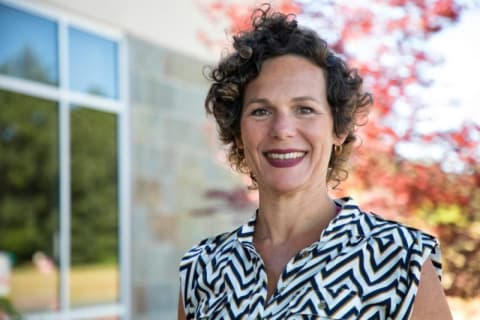
Hearts of Service | Mary Anne Gould
Story 31

Raised by parents who were social workers and activists, Mary Anne Gould grew up with an emphasis on the importance of helping the underserved. This was one reason she decided to start a new career two and a half years ago at Adventist Health.
“Initially my role was to be the main substance use navigator for Howard Memorial,” Mary Anne explains. “Then as the program grew and was developed, it was clear the other hospitals wanted to have the program, as well. We reapplied when there was additional funding and expanded the program to all three hospitals.”
Now Mary Anne oversees the substance use recovery program, which is called California Bridge and staffs a navigator at each of the Adventist Health hospitals in Mendocino County: Howard Memorial, Ukiah Valley and Mendocino Coast.

“We provide a compassionate, non-judgmental approach to patients with substance use who come into the emergency department,” Mary Anne explains. “This includes a brief screening and intake about their life and their history, and we meet them where they are to engage them in treatment.”
Patients are typically identified by a triage nurse in the Emergency Department, either through a series of screening questions or symptoms. “They're screened in the ER, they're discharged with the treatment option or support they agree with, and then we continue the relationship working with them once they've discharged,” Mary Anne says.
“We provide a compassionate, non-judgmental approach to patients with substance use who come into the emergency department.”
Until joining Adventist Health, Mary Anne worked as a childbirth educator and doula, as well as a yoga and fitness instructor. She says in many ways her past has prepared her for this profession.
“Coaching is a big part of the work that I do [now],” she explains. “When I'm working with people and I'm watching them go through their process of recovery – from that first moment of engaging with them, through all of the decision-making around their treatment program, and then into active recovery and sobriety – it reminds me of labor. It reminds me of that process of really working through those challenging parts of change and of growth and adaptation to whatever is being presented to you.”

Over the last two and a half years, more than 100 people have been actively engaged in the Bridge MAT (medication-assisted treatment) Clinic, which is run by Adventist Health in Mendocino County and offers ongoing treatment for patients with opiate use disorder, stimulant use disorder and alcohol use disorder. Daniel Brown is one of them. Over a year ago, Daniel decided to seek help for his addiction and found the program.
“When I reached out, I was put in touch with Mary Anne,” Daniel recalls. “She reassured me that coming up and getting treatment was going to be the number one way to get better.”
At the hospital, Daniel received treatment to initiate his recovery process, and he continues to participate in Adventist Health’s MAT program.
“There's never been anything but uplifting and healing."
“They see people through from that initial emergency room encounter and help you get into a program where you're consistently meeting with a doctor and a counselor,” he shares. “That was amazing, because if that wasn't [Mary Anne’s] job position, I would have gone in and been a one-time treatment. I would have been back out once I ran out of what was prescribed at the ER. I certainly wouldn't have had a follow-up appointment, and I would have been back in my addiction.”
Daniel says he has told other people about the program with the hope that they will find the healing he has found.
“There's never been judgment,” he adds. “There's never been anything but uplifting and healing. That's amazing, because it would be easy ... I've seen people that I've recommended come up and join the program after they saw what I needed. I've seen some people stick with it, and I've seen some people not. But I am just so amazed because that is such a hard job – to be there with people when they're at their absolute worst, lowest, and to help build them back up.”
Related stories

Todd Reese

Robert Ferguson

Judy Leach

Jennifer Diehl

Jen Jacobs

Restoration | Michael's Story

The Journey | Barbara’s Story

Healing Hands

Survivor | Tiffany's Story

Survivor | Chei's Story

Lighting the Way

Richard & Lula

No Longer Alone

More Than Coincidence

A Race to Survival

Angels at Work

One in a Thousand | Fadi's Story

Medicine and Miracles

Meredith Jobe
